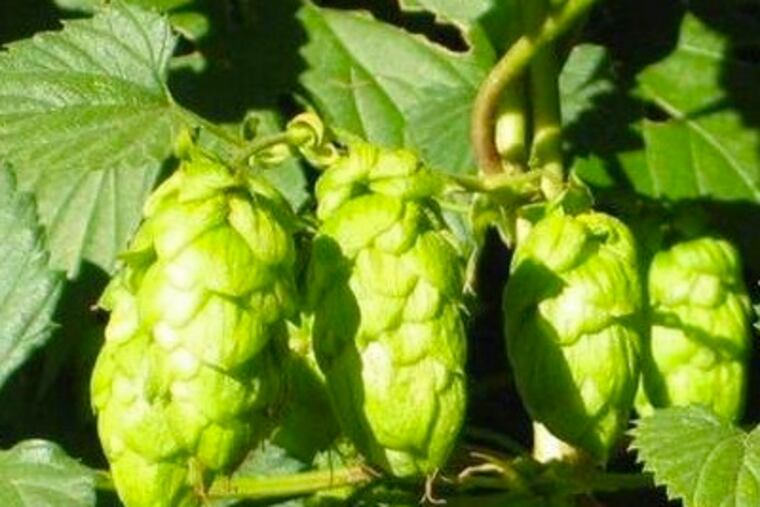Joe Sixpack at BrewExpo America
SAN DIEGO — The loneliest guy at BrewExpo America had to be Ales Kopecky, a Czech farmer who came to the annual beer-making trade show to promote his old-world Saaz hops. The Saaz variety may be the noblest of the so-called “noble hops,” providing the distinctive flavor and palate-cleansing bitterness to pilsners and other styles. Yet few brewers lined up to savor the aroma from the pile of dried hops scattered atop Kopecky’s booth.

SAN DIEGO — The loneliest guy at BrewExpo America had to be Ales Kopecky, a Czech farmer who came to the annual beer-making trade show to promote his old-world Saaz hops.
The Saaz variety may be the noblest of the so-called "noble hops," providing the distinctive flavor and palate-cleansing bitterness to pilsners and other styles. Yet few brewers lined up to savor the aroma from the pile of dried hops scattered atop Kopecky's booth.
They were drawn instead to the Hopsteiner booth, where the multinational company was showing off its new Calypso hops variety. Or the display from Deutscher Hopfen, the German hop-growing cooperative that had just unveiled its Polaris variety.
Even the guy selling French hops drew a bigger crowd, offering a pair of hybrids named Aramis and Triskel.
New hop varieties are the darlings of craft brewing today. If you take a look at the tap lineup at your favorite bar, you already know the reason: India pale ale.
In most mainstream domestic lagers, hops are used merely to balance the sweetness of malt. It doesn't really matter what variety goes into that notoriously triple-hopped bottle of Miller Lite, for example; the only thing the big brewers really care about is the hops' content of alpha acid — the main bitter compounds needed to make beer. (And not too much, either: Who doesn't remember those old Keystone Light ads that mocked the mouth-drying tang of hops as "bitter beer face"?)
But as Mike Sutton, a sales veep at Hopsteiner, noted, "The game has shifted."
Craft beer is all about full flavor, and the beauty of hops — their garden-like aroma, their citrus flavor, their spiciness, their oily resins — has been rediscovered.
Nowhere is that more evident than in India pale ale, the hoppiest of beer styles that is now, stunningly, the No. 1 style among American craft brewers, according to the Brewers Association.
More than ever, beer drinkers love their hops.
Not just the classic Cascades variety of the Northwest that came to define so many ales. They're crazy for Columbia, Centennial, Columbus, Cluster and Chinook. They're going nuts for Nugget, loco for Liberty and ape for Amarillo.
Beer makers now commonly list hop varieties on labels or even name their brands after them (e.g., Troegs Nugget Nectar, Weyerbacher Double Simcoe IPA).
"Hops are the easiest ingredient to change out," explained Sutton. Depending on their application — in the initial wort boil for bitterness or in the final dry-hopping stage for aroma — Sutton said, "You can change varieties and create a whole different flavor … It's like reaching into your spice cabinet."
Where growers once cultivated hops that mainly maximized alpha acid content, they're now developing hybrids with specific flavor or aroma attributes.
"It's the one message we heard loud and clear from craft brewing," Sutton said. "They want aroma, not alpha."
His company's new Calypso variety has hints of pear and apple.
Meanwhile, the new French Triskel — a variety its producers said could be used in everything from pilsner to IPA — is fruity and floral.
Even the famously conservative German hop growers, known for their classic Hallertauer and Tettnanger hops, are getting into the game.
Eric Toft, head brewer at Germany's Schönram brewery and a representative of Deutscher Hopfen, crushed open some buds from a new variety called Polaris that smelled minty, like eucalyptus.
"We're trying to meet the demand for new varieties, mainly from America and Italy," Toft said. "They've kind of opened our mind."
How did the Polaris taste? Visitors lined up for samples of a test batch of IPA that Toft and Ron Barchet of Victory Brewing created with the new hops. The ale was fresh and lively, yet well-balanced and very easy to drink.
Back at the Czech hops display, things were slow but not completely dead.
"Saaz is still 80 to 90 percent of the volume in the Czech Republic," Kopecky said. "But new varieties are the tendency of brewing today, and we must follow that tendency."
Thus, next to the mound of wonderful Saaz, a new hybrid was displayed: Saaz Special.
Look for it in a glass of beer coming soon to a bar near you.
"Joe Sixpack" is by Don Russell, director of Philly Beer Week. For more on the beer scene, sign up for his weekly email update at www.joesixpack.net. E-mail: joesixpack@phillynews.com.